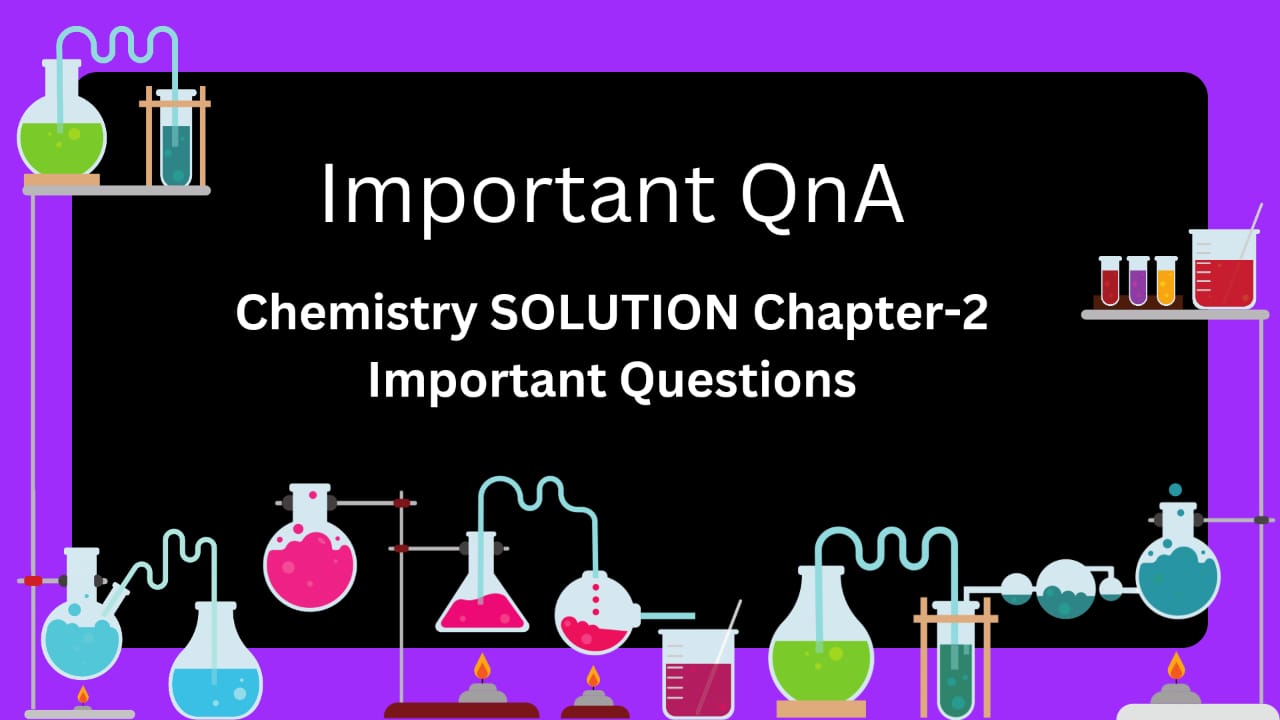Solutions class 12 chemistry
Here some important questions of NCERT chapter-2 solutions class 12 chemistry, which are asked most of the time in CBSE board exams. Practice the questions with answers.
Class 12 Chemistry Solution chapter important Questions
MCQ
1. Low concentration of oxygen in the blood and tissues of people living at high altitude is due to
.
(i)low temperature
(ii)low atmospheric pressure
(iii)high atmospheric pressure
(iv)both low temperature and high atmospheric pressure
Ans. (ii)
Explanation: At high altitude, due to low atmospheric pressure the solubility of oxygen in blood get decreased.
2. Considering the formation, breaking and strength of hydrogen bond, predict which of the following mixtures will show a positive deviation from Raoult’s law?
(i)Methanol and
(ii) Chloroform and acetone.
(iii) Nitric acid and water.
(iv) Phenol and aniline.
Ans. (i)
Explanation: A-A interaction is greater than the A-B interaction. Intermolecular hydrogen bonding in methanol is more than methanol and acetone. So, methanol and acetone mixtures will show a positive deviation from Raoult’s law.
3. Colligative properties depend on .
(i)the nature of the solute particles dissolved in
(ii)the number of solute particles in
(iii)the physical properties of the solute particles dissolved in
(iv)the nature of solvent
Ans. (ii)
4. Which of the following aqueous solutions should have the highest boiling point?
(i) 1.0 M NaOH
(ii) 1.0 M Na2SO4
(iii) 1.0 M NH4NO3
(iv) 1.0 M KNO3
Ans. (ii)
Explanation: In 1.0 N Na2SO4 solution i> 1. So, the no. of ions dissociated will be more.
5. The unit of Ebulioscopic constant is .
(i)K kg mol–1 or K(molality)-1
(ii) mol kg K–1 or K–1(molality)
(iii) kg mol–1 K–1 or K–1(molality)–1
(iv) K mol kg–1 or K(molality)
Ans. (i)
6. In comparison to a 01 M solution of glucose, the depression in freezing point of a 0.01 M MgCl2 solution is .
(i) the same
(ii) about twice
(iii) about three times
(iv) about six times
Ans. (iii)
Explanation: van’t. Hoff factor of MgCl2=3 that is why depression in freezing point will be three times.
7. An unripe mango placed in a concentrated salt solution to prepare pickle, shrivels because .
(i) it gains water due to osmosis.
(ii) it loses water due to reverse osmosis.
(iii) it gains water due to reverse osmosis.
(iv) it loses water due to osmosis.
Ans. (iv)
8.At a given temperature, osmotic pressure of a concentrated solution of a substance
.
(i) is higher than that at a dilute solution.
(ii) is lower than that of a dilute solution.
(iii) is same as that of a dilute solution.
(iv) cannot be compared with osmotic pressure of dilute solution.
Ans: (i)
9. A plant cell shrinks when it is kept in a
(i) hypotonic solution (ii) hypertonic solution (iii) isotonic solution (iv) pure water
Ans. (ii) hypertonic solution
10. The values of van’t Hoff factors for KCl, NaCl and K2SO4, respectively, are .
(i) 2, 2 and 2 (ii) 2, 2 and 3 (iii) 1, 1 and 2 (iv) 1, 1 and 1
Ans. (ii)
click here for –> More number of MCQ of class 12 solution chapter
Chapter 2 chemistry class 12 Important Questions : Short Answer Type
Short Answer Type Questions (SA-2 Marks)
11. Determine the osmotic pressure of a solution prepared by dissolving 25 mg of K2SO4 in 2 litres of water at 25° C, assuming that it is completely dissociated.
Ans. If K2SO4 is completely dissociated, then i = 3 Molar mass of K2SO4 = 174
π = i cRT= i (nB/V) RT = i (wB RT/MBV)
= 3 x 25 x10-3 x 0.082 x 298 / 174 x 2
π = 5.27 x 10-3 atm.
12. a) Molal elevation constant for benzene is 52 K/m. A solution of some organic substance in benzene boils at 0.126oC higher than benzene. What is the molality of the solution?
- What are the values of van’t Hoff factor for NaCl and K2SO4, respectively?
Ans: a) ΔTb= Kb m , molality=0.05m
- b) 2 and 3
13. a) State Henry’s law.
- Which cold drink you prefer one chilled or other one at room temperature and why?
- At the same temperature hydrogen is more soluble in water than helium. Which of them will have higher value of KH and why?
Ans: a) Mole fraction of gas in the solution is directly proportional to partial pressure of gas in the vapour phase
- Chilled as solubility of CO2 is more at low
- Helium, as greater the KH value lower the solubility
14.Calculate Henry‘s law constant when the solubility of H2S(a toxic gas with rotten egg like smell)in water at STP is 0.195 m
Answer: Moles of H2S=0.195,Moles of water = 55.55, Mole fraction =0.0035p =KHx, KH=p/x=0.987 bar/0.0035 =282 bar
15.Find the vapour pressure of water and its relative lowering in the solution which is 50 g of urea(NH2CONH2) dissolved in 850 gof water. (Vapour pressure of pure water at 298 K is 23.8mmHg)
Answer: Mole of urea= 50/600.833,
Moles of water=850/18=47.222
Mole fraction of urea=0.0173
(P0A– PA)/P0A= xB, PA=23.39 mm of Hg,
the vapour pressure of water in the given solution is 23.39 mm of Hg and its
relative lowering is 0.0173.
16. What is meant by positive deviation from Roult’s Law? Give an example and what is the sign of ΔHmix and ΔVmix for positive deviation?
Ans :Positive deviation : For non-ideal solutions, if the vapour pressure is higher, then it is said to exhibit positive deviation. A-B interactions are weaker than A-A or B-B interactions. Due to this, vapour pressure increases which results in positive deviation. In positive deviation, intermolecular force decreases, volume increases, vapour pressures increases. enthalpy increases.
Examples: ethanol + acetone and carbon disulphide + acetone show positive deviation.
ΔHmix =Ve, ΔVmix = + ve.
Q17. Define azeotropes. What type of azeotrope is formed by positive deviation from Raoult’s law? Give an example.
Ans: Azeotropes are the binary mixtures of solutions that have the same composition in liquid and vapour phases and that have constant boiling points. It is not possible to separate the components of azeotropes by fractional distillation. showing a large positive deviation from Raoult’s law at a specific composition. For example an ethanol & water mixture containing approximately 95% ethanol by volume
Q18 If 1.202 g mL-1 is the density of 20% aqueous KI, determine the following:
(a) Molality of KI (b) Molarity of KI (c)Mole fraction of KI
Ans. 20% solution of KI means 20g of KI are present in 100g of solution or 80g of water.
Molar mass of KI = 166
Moles of KI = 20/166 = 0.120 Molality =0.120 x 1000 /80 = 1.5 m
Volume of solution = 100/1.202 = 83.19 ml Molarity = 120 x 1000 / 83.19 = 1.44 M
Moles of KI = 20/166 = 120 Moles of water = 80/18 = 4.44
Mole fraction of KI 0.120/(4.44+0.120) = 0.0263
Q19. List any four factors on which the colligative properties of a solution depend.
Ans: (i) Number of particles of solute association or dissociation of solute Concentration of solute Temperature
Q20. Outer hard shells of two eggs are removed. One of the egg is placed in pure water and the other is placed in saturated solution of sodium chloride. What will be observed and why?
Ans: The egg placed in pure water will swell because the concentration of proteins is high inside the egg as compared to water. Therefore, endosmosis occurs and water diffuses through the semipermeable membrane. The egg which is placed in sodium chloride solution will shrink due to osmosis of water out of the egg.
Q21. 2 g of benzoic acid (C6H5COOH) dissolved in 25 g of benzene shows a depression in freezing point equal to 1.62 K. Molal depression constant for benzene is 4.9 K kg mol–1. What is the percentage association of acid I fit forms dimer in solution?
Answer: MB = 241.98 g mol-1, Molecular mass of C6H5COOH = 122 g mol-1
2C6H5COOH⇌(C6H5COOH)2,
Degree of association of benzoic acid in benzene=99.2%
Q22. 0.6 mL of acetic acid (CH3COOH), having density 1.06 g mL–1, is dissolved in 1 liter of water. The depression in freezing point observed for this strength of acid was 0.0205°C. Calculate the Van‘t Hoff factor and the dissociation constant of acid.
Answer: Molality=0.0106molkg-1, ∆Tf=0.0197K Van‘t Hoff factor (i)=1.041
Dissociation constant of acid Ka =1.86 x10-5
Q23.Determine the amount of CaCl2 (i= 2.47) dissolved in 2.5 litre of water such that its osmotic pressure is 0.75atm at 27° C.
Answer: i= 2.47, ᴨ = i c RT = i (nB/V) RTnB
=0.0308 mol
Amount of CaCl2 dissolved=0.0308×111=3.42g.
Q24.Determine the osmotic pressure of a solution prepared by dissolving 25 mg of K2SO4 in 2 litre of water at 25° C, assuming that it is completely dissociated.
Answer: If K2SO4is completely dissociated, Here i= 3 ᴨ= i c RT =i (nB/V)RT =i(wB/ MB V)RT=5.27 x10-3atm.
Q25. How much of sucrose is to be added to 500 g of water such that it boils at 100°C if the molar elevation constant for water is 0.52 K kg mol-1 and the boiling point of water at 750 mm Hg is 99.63°C?
Answer:∆Tb=100 – 99.63=0.370, wB =121.67 g,
The amount of sucrose that is to be added is 121.67 g
Solution chapter Assertion and Reason Type Questions
In the following questions two statements are given- one labeled Assertion (A) and the other labeled Reason (R).
Select the correct answer from the codes (a), (b), (c) and (d) as given below:
- Both Assertion (A) and Reason (R) are correct statements and Reason (R) is the correct explanation of Assertion (A).
- Both Assertion (A) and Reason (R) are correct statements but Reason (R) is not the correct explanation of Assertion (A).
- Assertion (A) is correct but Reason (R) is incorrect
- Assertion (A) is incorrect but Reason (R) is correct
Q-1: Assertion (A) : A mixture of chloroform and acetone forms a non-ideal solution with positive
Reason (R) : Acetone is more volatile than chloroform.
Q-2: Assertion (A) : In reverse osmosis, pressure higher than osmotic pressure has to be applied.
Reason (R) : Higher pressure pushes the solution from one side of the semipermeable membrane to the other side
Q-3: Assertion (A) : Out of various colligative properties, osmotic pressure is used for determination of molecular masses of polymers.
Reason (R) : polymer solutions do not possess constant boiling point or freezing point.
Q-4: Assertion (A) : Molarity of a solution in liquid state changes with Reason (R) :The volume of a solution changes with change in temperature.
Q-5: Assertion (A) : When methyl alcohol is added to water, boiling point of water
Reason (R) : When a volatile solute is added to a volatile solvent, elevation in boiling point is observed.
- (d) (c) 3. (b) 4. (a) 5. (d)
Frequently Asked Questions (FAQ)
Define azeotropes
Azeotropes are the binary mixtures of solutions that have the same composition in liquid and vapour phases and that have constant boiling points.
At the same temperature hydrogen is more soluble in water than Helium. Which of them will have higher value of KH and why?
Helium, as greater the KH value lower the solubility
What is meant by positive deviation from Roult’s Law? Give an example
Positive deviation: For non-ideal solutions, if the vapour pressure is higher, then it is said to exhibit positive deviation. A-B interactions are weaker than A-A or B-B interactions. Due to this, vapour pressure increases which results in positive deviation. In positive deviation, intermolecular force decreases, volume increases, vapour pressures increases. enthalpy increases.
Examples: ethanol + acetone and carbon disulphide + acetone show positive deviation.
Boost your Practice with sample paper provided here for your Annual Exam preparation


Comments are closed.